Deck 5: Exponential and Logarithmic Functions
Question
Question
Question
Question
Question
Question
Question
Question
Question
Question
Question
Question
Question
Question
Question
Question
Question
Question
Question
Question
Question
Question
Question
Question
Question
Question
Question
Question
Question
Question
Question
Question
Question
Question
Question
Question
Question
Question
Question
Question
Question
Question
Question
Question
Question
Question
Question
Question
Question
Question
Question
Question
Question
Question
Question
Question
Question
Question
Question
Question
Question
Question
Question
Question
Question
Question
Question
Question
Question
Question
Question
Question
Question
Question
Question
Question
Question
Question
Question
Question

Unlock Deck
Sign up to unlock the cards in this deck!
Unlock Deck
Unlock Deck
1/278
Play
Full screen (f)
Deck 5: Exponential and Logarithmic Functions
1
On the basis of data collected during an experiment, a biologist found that the growth of the fruit fly (Drosophila) with a limited food supply could be approximated by the exponential model  where t denotes the number of days since the beginning of the experiment. How fast was the population changing on the 20th day?
where t denotes the number of days since the beginning of the experiment. How fast was the population changing on the 20th day?
A)19 flies/day
B)17 flies/day
C)16 flies/day
D)20 flies/day
E)18 flies/day
 where t denotes the number of days since the beginning of the experiment. How fast was the population changing on the 20th day?
where t denotes the number of days since the beginning of the experiment. How fast was the population changing on the 20th day?A)19 flies/day
B)17 flies/day
C)16 flies/day
D)20 flies/day
E)18 flies/day
17 flies/day
2
According to data obtained from the CBO, the total federal debt (in trillions of dollars) from 2001 through 2006 is given by 
 where t is measured in years, with
where t is measured in years, with  corresponding to 2001.How fast was the total federal debt increasing in 2002? round answer to three decimal places.
corresponding to 2001.How fast was the total federal debt increasing in 2002? round answer to three decimal places.
A)
B)
C)
D)
E)

 where t is measured in years, with
where t is measured in years, with  corresponding to 2001.How fast was the total federal debt increasing in 2002? round answer to three decimal places.
corresponding to 2001.How fast was the total federal debt increasing in 2002? round answer to three decimal places.A)

B)

C)

D)

E)


3
The radioactive element polonium decays according to the law  where
where  is the initial amount and the time t is measured in days.If the amount of polonium left after 560 days is 40 mg, what was the initial amount present?
is the initial amount and the time t is measured in days.If the amount of polonium left after 560 days is 40 mg, what was the initial amount present?
A)The initial amount was 642 mg
B)The initial amount was 640 mg
C)The initial amount was 635 mg
D)The initial amount was 629 mg
 where
where  is the initial amount and the time t is measured in days.If the amount of polonium left after 560 days is 40 mg, what was the initial amount present?
is the initial amount and the time t is measured in days.If the amount of polonium left after 560 days is 40 mg, what was the initial amount present?A)The initial amount was 642 mg
B)The initial amount was 640 mg
C)The initial amount was 635 mg
D)The initial amount was 629 mg
The initial amount was 640 mg
4
The change from religious to lay teachers at Roman Catholic schools has been partly attributed to the decline in the number of women and men entering religious orders.The percent of teachers who are lay teachers is given by  where t is measured in decades, with
where t is measured in decades, with  corresponding to the beginning of 1960. Find the year when the percent of lay teachers was increasing most rapidly.
corresponding to the beginning of 1960. Find the year when the percent of lay teachers was increasing most rapidly.
A)1970
B)1983
C)1976
D)2000
E)1962
 where t is measured in decades, with
where t is measured in decades, with  corresponding to the beginning of 1960. Find the year when the percent of lay teachers was increasing most rapidly.
corresponding to the beginning of 1960. Find the year when the percent of lay teachers was increasing most rapidly.A)1970
B)1983
C)1976
D)2000
E)1962

Unlock Deck
Unlock for access to all 278 flashcards in this deck.
Unlock Deck
k this deck
5
A certain piece of machinery was purchased 4 year(s) ago by Garland Mills for $400,000.Its present resale value is $256,000.Assuming that the machine's resale value decreases exponentially, what will it be 2 year(s) from now?
A)The resale value of the machinery will be $204,789
B)The resale value of the machinery will be $204,911
C)The resale value of the machinery will be $204,800
D)The resale value of the machinery will be $203,689
A)The resale value of the machinery will be $204,789
B)The resale value of the machinery will be $204,911
C)The resale value of the machinery will be $204,800
D)The resale value of the machinery will be $203,689

Unlock Deck
Unlock for access to all 278 flashcards in this deck.
Unlock Deck
k this deck
6
Phosphorus 32 has a half-life of 14.2 days.If 100 g of this substance are present initially, find the amount present after t days.What amount will be left after 7.1 days? How fast is the phosphorus 32 decaying when t = 7.1?
A)
B)
C)
D)
A)

B)

C)

D)


Unlock Deck
Unlock for access to all 278 flashcards in this deck.
Unlock Deck
k this deck
7
If the temperature is constant, then the atmospheric pressure P (in pounds/square inch) varies with the altitude above sea level h in accordance with the law  where
where  is the atmospheric pressure at sea level and k is a constant. If the atmospheric pressure is
is the atmospheric pressure at sea level and k is a constant. If the atmospheric pressure is  at sea level and
at sea level and  at 5,000 ft, how fast is the atmospheric pressure changing with respect to altitude at an altitude of 15,000 ft? Give the answer to four decimal places.
at 5,000 ft, how fast is the atmospheric pressure changing with respect to altitude at an altitude of 15,000 ft? Give the answer to four decimal places.
A)
B)
C)
D)
E)
 where
where  is the atmospheric pressure at sea level and k is a constant. If the atmospheric pressure is
is the atmospheric pressure at sea level and k is a constant. If the atmospheric pressure is  at sea level and
at sea level and  at 5,000 ft, how fast is the atmospheric pressure changing with respect to altitude at an altitude of 15,000 ft? Give the answer to four decimal places.
at 5,000 ft, how fast is the atmospheric pressure changing with respect to altitude at an altitude of 15,000 ft? Give the answer to four decimal places.A)

B)

C)

D)

E)


Unlock Deck
Unlock for access to all 278 flashcards in this deck.
Unlock Deck
k this deck
8
Wood deposits recovered from an archeological site contain 25% of the carbon 14 they originally contained.How long ago did the tree from which the wood was obtained die? Hint: the decay constant k for carbon 14 is equal to 0.00012.
A)The tree died 10,429 year(s) ago.
B)The tree died 11,552 year(s) ago.
C)The tree died 13,084 year(s) ago.
D)The tree died 8,096 year(s) ago.
A)The tree died 10,429 year(s) ago.
B)The tree died 11,552 year(s) ago.
C)The tree died 13,084 year(s) ago.
D)The tree died 8,096 year(s) ago.

Unlock Deck
Unlock for access to all 278 flashcards in this deck.
Unlock Deck
k this deck
9
The percent of a certain brand of computer chips that will fail after t years of use is estimated to be  . What percent of this brand of computer chips are expected to be usable after 3 years?
. What percent of this brand of computer chips are expected to be usable after 3 years?
A)52.6%
B)46.9%
C)33.7%
D)45.5%
 . What percent of this brand of computer chips are expected to be usable after 3 years?
. What percent of this brand of computer chips are expected to be usable after 3 years?A)52.6%
B)46.9%
C)33.7%
D)45.5%

Unlock Deck
Unlock for access to all 278 flashcards in this deck.
Unlock Deck
k this deck
10
During a flu epidemic, the number of children in the Woodbridge Community School System who contracted influenza after t days was given by  . How many children were stricken by the flu after the first day? How many children had the flu after 10 days? How many children eventually contracted the disease?
. How many children were stricken by the flu after the first day? How many children had the flu after 10 days? How many children eventually contracted the disease?
A)13 children were stricken by the flu after the first day; 1,264 children had the flu after 10 days; 883 children eventually contracted the disease
B)10 children were stricken by the flu after the first day; 1,264 children had the flu after 10 days; 1,200 children eventually contracted the disease
C)13 children were stricken by the flu after the first day; 1,125 children had the flu after 10 days; 1,200 children eventually contracted the disease
D)15 children were stricken by the flu after the first day; 1,125 children had the flu after 10 days; 1,354 children eventually contracted the disease
 . How many children were stricken by the flu after the first day? How many children had the flu after 10 days? How many children eventually contracted the disease?
. How many children were stricken by the flu after the first day? How many children had the flu after 10 days? How many children eventually contracted the disease?A)13 children were stricken by the flu after the first day; 1,264 children had the flu after 10 days; 883 children eventually contracted the disease
B)10 children were stricken by the flu after the first day; 1,264 children had the flu after 10 days; 1,200 children eventually contracted the disease
C)13 children were stricken by the flu after the first day; 1,125 children had the flu after 10 days; 1,200 children eventually contracted the disease
D)15 children were stricken by the flu after the first day; 1,125 children had the flu after 10 days; 1,354 children eventually contracted the disease

Unlock Deck
Unlock for access to all 278 flashcards in this deck.
Unlock Deck
k this deck
11
The length (in centimeters) of a typical Pacific halibut t years old is approximately  . What is the length of a typical 6-year-old Pacific halibut? How fast is the length of a typical 6-year-old Pacific halibut increasing? What is the maximum length a typical Pacific halibut can attain?
. What is the length of a typical 6-year-old Pacific halibut? How fast is the length of a typical 6-year-old Pacific halibut increasing? What is the maximum length a typical Pacific halibut can attain?
A)151.2 cm; 0.957 cm/yr; 226 cm;
B)138.1 cm; 11.6 cm/yr; 199 cm;
C)199.0 cm; 13.7 cm/yr; 253 cm;
D)108.3 cm; 12.3 cm/yr; 199 cm;
 . What is the length of a typical 6-year-old Pacific halibut? How fast is the length of a typical 6-year-old Pacific halibut increasing? What is the maximum length a typical Pacific halibut can attain?
. What is the length of a typical 6-year-old Pacific halibut? How fast is the length of a typical 6-year-old Pacific halibut increasing? What is the maximum length a typical Pacific halibut can attain?A)151.2 cm; 0.957 cm/yr; 226 cm;
B)138.1 cm; 11.6 cm/yr; 199 cm;
C)199.0 cm; 13.7 cm/yr; 253 cm;
D)108.3 cm; 12.3 cm/yr; 199 cm;

Unlock Deck
Unlock for access to all 278 flashcards in this deck.
Unlock Deck
k this deck
12
Given that a quantity Q(t) is described by the exponential growth function  where t is measured in minutes.What is the growth constant? What quantity is present initially? Complete the table of values.Round your answers to the nearest integer.
where t is measured in minutes.What is the growth constant? What quantity is present initially? Complete the table of values.Round your answers to the nearest integer. 
A)k = 600; Q = 0.03 t 0 10 20 100
Q 600 815 1,104 12,051
B)k = 0.03; Q = 600 t 0 10 20 100
Q 600 810 1,104 12,162
C)k = 0.03; Q = 600 t 0 10 20 100
Q 600 810 1,093 12,051
D)k = 600; Q = 0.03 t 0 10 20 100
Q 600 810 1,093 12,051
 where t is measured in minutes.What is the growth constant? What quantity is present initially? Complete the table of values.Round your answers to the nearest integer.
where t is measured in minutes.What is the growth constant? What quantity is present initially? Complete the table of values.Round your answers to the nearest integer. 
A)k = 600; Q = 0.03 t 0 10 20 100
Q 600 815 1,104 12,051
B)k = 0.03; Q = 600 t 0 10 20 100
Q 600 810 1,104 12,162
C)k = 0.03; Q = 600 t 0 10 20 100
Q 600 810 1,093 12,051
D)k = 600; Q = 0.03 t 0 10 20 100
Q 600 810 1,093 12,051

Unlock Deck
Unlock for access to all 278 flashcards in this deck.
Unlock Deck
k this deck
13
According to data obtained from the CBO, the total federal debt (in trillions of dollars) from 2001 through 2006 is given by 
 where t is measured in years, with
where t is measured in years, with  corresponding to 2001.What was the total federal debt in 2004? Round answer to three decimal places.
corresponding to 2001.What was the total federal debt in 2004? Round answer to three decimal places.
A)
B)
C)
D)
E)

 where t is measured in years, with
where t is measured in years, with  corresponding to 2001.What was the total federal debt in 2004? Round answer to three decimal places.
corresponding to 2001.What was the total federal debt in 2004? Round answer to three decimal places.A)

B)

C)

D)

E)


Unlock Deck
Unlock for access to all 278 flashcards in this deck.
Unlock Deck
k this deck
14
Strontium 90, a radioactive isotope of strontium, is present in the fallout resulting from nuclear explosions.It is especially hazardous to animal life, including humans, because, upon ingestion of contaminated food, it is absorbed into the bone structure.Its half-life is 27 years.If the amount of strontium 90 in a certain area is found to be four times the "safe" level, find how much time must elapse before an "acceptable level" is reached.
A)30.3 year(s) must elapse before an "acceptable level" is reached.
B)54 year(s) must elapse before an "acceptable level" is reached.
C)57 year(s) must elapse before an "acceptable level" is reached.
D)39 year(s) must elapse before an "acceptable level" is reached.
A)30.3 year(s) must elapse before an "acceptable level" is reached.
B)54 year(s) must elapse before an "acceptable level" is reached.
C)57 year(s) must elapse before an "acceptable level" is reached.
D)39 year(s) must elapse before an "acceptable level" is reached.

Unlock Deck
Unlock for access to all 278 flashcards in this deck.
Unlock Deck
k this deck
15
According to estimates by Paul Kroger Associates, the percent of households that own VCRs is given by  where t is measured in years, with t = 0 corresponding to the beginning of 1985.What percent of households owned VCRs at the beginning of 1985? At the beginning of 1994?
where t is measured in years, with t = 0 corresponding to the beginning of 1985.What percent of households owned VCRs at the beginning of 1985? At the beginning of 1994?
A)64.1%; 67.0%
B)3.0%; 62.7%
C)0.9%; 63.4%
D)0.9%; 64.1%
 where t is measured in years, with t = 0 corresponding to the beginning of 1985.What percent of households owned VCRs at the beginning of 1985? At the beginning of 1994?
where t is measured in years, with t = 0 corresponding to the beginning of 1985.What percent of households owned VCRs at the beginning of 1985? At the beginning of 1994?A)64.1%; 67.0%
B)3.0%; 62.7%
C)0.9%; 63.4%
D)0.9%; 64.1%

Unlock Deck
Unlock for access to all 278 flashcards in this deck.
Unlock Deck
k this deck
16
Skeletal remains of the so-called "Pittsburgh Man", unearthed in Pennsylvania, had lost 86% of the carbon 14 they originally contained.Determine the approximate age of the bones.Hint: the decay constant k for carbon 14 is equal to 0.00012.
A)The approximate age of bones is 14,852 year(s).
B)The approximate age of bones is 12,928 year(s).
C)The approximate age of bones is 16,384 year(s).
D)The approximate age of bones is 15,261 year(s).
A)The approximate age of bones is 14,852 year(s).
B)The approximate age of bones is 12,928 year(s).
C)The approximate age of bones is 16,384 year(s).
D)The approximate age of bones is 15,261 year(s).

Unlock Deck
Unlock for access to all 278 flashcards in this deck.
Unlock Deck
k this deck
17
The American Court Reporting Institute finds that the average student taking Advanced Machine Shorthand, an intensive 20-week course, progresses according to the function  ,
,  , where Q(t) measures the number of words (per minute) of dictation that the student can take in machine shorthand after t weeks in the course.Sketch the graph of the function Q and answer the following questions:
, where Q(t) measures the number of words (per minute) of dictation that the student can take in machine shorthand after t weeks in the course.Sketch the graph of the function Q and answer the following questions:
a.What is the beginning shorthand speed for the average student in this course?
b. What shorthand speed does the average student attain halfway through the course?
c. How many words per minute can the average student take after completing this course?
A)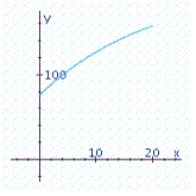
a.75 words/min b.126 words/min c.157 words/min
B)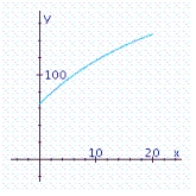
a.65 words/min b.116 words/min c.147 words/min
C)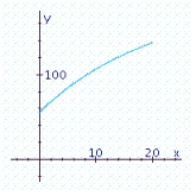
a.55 words/min b.106 words/min c.137 words/min
 ,
,  , where Q(t) measures the number of words (per minute) of dictation that the student can take in machine shorthand after t weeks in the course.Sketch the graph of the function Q and answer the following questions:
, where Q(t) measures the number of words (per minute) of dictation that the student can take in machine shorthand after t weeks in the course.Sketch the graph of the function Q and answer the following questions: a.What is the beginning shorthand speed for the average student in this course?
b. What shorthand speed does the average student attain halfway through the course?
c. How many words per minute can the average student take after completing this course?
A)

a.75 words/min b.126 words/min c.157 words/min
B)

a.65 words/min b.116 words/min c.147 words/min
C)

a.55 words/min b.106 words/min c.137 words/min

Unlock Deck
Unlock for access to all 278 flashcards in this deck.
Unlock Deck
k this deck
18
Given that a quantity Q(t) exhibiting exponential decay is described by the function  where t is measured in years.What is the decay constant? What quantity is present initially? Complete the table of values.Round your answer to the nearest integer.
where t is measured in years.What is the decay constant? What quantity is present initially? Complete the table of values.Round your answer to the nearest integer.

A)k = - 0.01; Q = 2,500 t 0 5 10 20 100
Q 2,500 2,378 2,262 2,047 920
B)k = - 0.01; Q = 2,500 t 0 5 10 20 100
Q 2,500 2,378 2,207 2,047 925
C)k = 2,500; Q = - 2,500 t 0 5 10 20 100
Q 2,500 2,489 2,207 2,058 925
D)k = 2,500; Q = - 2,500 t 0 5 10 20 100
Q 2,500 2,489 2,262 2,058 920
 where t is measured in years.What is the decay constant? What quantity is present initially? Complete the table of values.Round your answer to the nearest integer.
where t is measured in years.What is the decay constant? What quantity is present initially? Complete the table of values.Round your answer to the nearest integer.
A)k = - 0.01; Q = 2,500 t 0 5 10 20 100
Q 2,500 2,378 2,262 2,047 920
B)k = - 0.01; Q = 2,500 t 0 5 10 20 100
Q 2,500 2,378 2,207 2,047 925
C)k = 2,500; Q = - 2,500 t 0 5 10 20 100
Q 2,500 2,489 2,207 2,058 925
D)k = 2,500; Q = - 2,500 t 0 5 10 20 100
Q 2,500 2,489 2,262 2,058 920

Unlock Deck
Unlock for access to all 278 flashcards in this deck.
Unlock Deck
k this deck
19
The growth rate of the bacterium, a common bacterium found in the human intestine, is proportional to its size.Under ideal laboratory conditions, when this bacterium is grown in a nutrient broth medium, the number of cells in a culture doubles approximately every 20 min.If the initial cell population is 100, determine the function Q(t) that expresses the exponential growth of the number of cells of this bacterium as a function of time t (in minutes).How long will it take for a colony of 100 cells to increase to a population of 1 million? If the initial cell population were 1,000, how would this alter the model?
A)
B)
C)
D)
A)

B)

C)

D)


Unlock Deck
Unlock for access to all 278 flashcards in this deck.
Unlock Deck
k this deck
20
Universal Instruments found that the monthly demand for its new line of Galaxy Home Computers t months after placing the line on the market was given by  . Select the graph of this function.At what level is the demand expected to stabilize?
. Select the graph of this function.At what level is the demand expected to stabilize?
A) 2,000 computers
2,000 computers
B)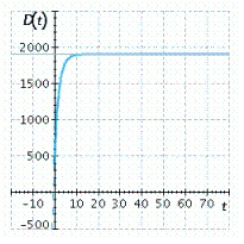 1,900 computers
1,900 computers
C)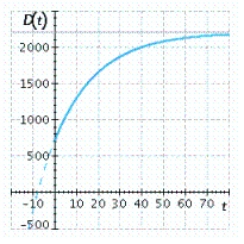 2,200 computers
2,200 computers
D)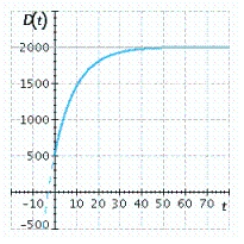 2,000 computers
2,000 computers
E)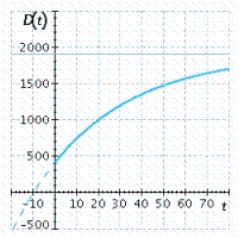 1,900 computers
1,900 computers
 . Select the graph of this function.At what level is the demand expected to stabilize?
. Select the graph of this function.At what level is the demand expected to stabilize?A)
 2,000 computers
2,000 computersB)
 1,900 computers
1,900 computersC)
 2,200 computers
2,200 computersD)
 2,000 computers
2,000 computersE)
 1,900 computers
1,900 computers
Unlock Deck
Unlock for access to all 278 flashcards in this deck.
Unlock Deck
k this deck
21
Strontium 90, a radioactive isotope of strontium, is present in the fallout resulting from nuclear explosions.It is especially hazardous to animal life, including humans, because, upon ingestion of contaminated food, it is absorbed into the bone structure.Its half-life is 27 years.If the amount of strontium 90 in a certain area is found to be four times the "safe" level, find how much time must elapse before an "acceptable level" is reached.
__________ years
__________ years

Unlock Deck
Unlock for access to all 278 flashcards in this deck.
Unlock Deck
k this deck
22
The length (in centimeters) of a typical Pacific halibut t years old is approximately  .What is the length of a typical 6-year-old Pacific halibut? How fast is the length of a typical 6-year-old Pacific halibut increasing? What is the maximum length a typical Pacific halibut can attain? Round your answers to the nearest tenth.
.What is the length of a typical 6-year-old Pacific halibut? How fast is the length of a typical 6-year-old Pacific halibut increasing? What is the maximum length a typical Pacific halibut can attain? Round your answers to the nearest tenth. 
 .What is the length of a typical 6-year-old Pacific halibut? How fast is the length of a typical 6-year-old Pacific halibut increasing? What is the maximum length a typical Pacific halibut can attain? Round your answers to the nearest tenth.
.What is the length of a typical 6-year-old Pacific halibut? How fast is the length of a typical 6-year-old Pacific halibut increasing? What is the maximum length a typical Pacific halibut can attain? Round your answers to the nearest tenth. 

Unlock Deck
Unlock for access to all 278 flashcards in this deck.
Unlock Deck
k this deck
23
The U.S.population is approximated by the function  where P(t) is measured in millions of people and t is measured in 30-year intervals, with t = 0 corresponding to 1930.What is the expected population of the United States in 2050 ( t = 4 )?
where P(t) is measured in millions of people and t is measured in 30-year intervals, with t = 0 corresponding to 1930.What is the expected population of the United States in 2050 ( t = 4 )?
A)616.6 millions
B)398.6 millions
C)401.6 millions
D)404.0 millions
 where P(t) is measured in millions of people and t is measured in 30-year intervals, with t = 0 corresponding to 1930.What is the expected population of the United States in 2050 ( t = 4 )?
where P(t) is measured in millions of people and t is measured in 30-year intervals, with t = 0 corresponding to 1930.What is the expected population of the United States in 2050 ( t = 4 )?A)616.6 millions
B)398.6 millions
C)401.6 millions
D)404.0 millions

Unlock Deck
Unlock for access to all 278 flashcards in this deck.
Unlock Deck
k this deck
24
According to estimates by Paul Kroger Associates, the percent of households that own VCRs is given by  , where t is measured in years, with t = 0 corresponding to the beginning of 1985.
, where t is measured in years, with t = 0 corresponding to the beginning of 1985.
What percent of households owned VCRs at the beginning of 1985? Round your answer to the nearest tenth.
__________%
At the beginning of 1993?.Round your answer to the nearest tenth.
__________%
 , where t is measured in years, with t = 0 corresponding to the beginning of 1985.
, where t is measured in years, with t = 0 corresponding to the beginning of 1985.What percent of households owned VCRs at the beginning of 1985? Round your answer to the nearest tenth.
__________%
At the beginning of 1993?.Round your answer to the nearest tenth.
__________%

Unlock Deck
Unlock for access to all 278 flashcards in this deck.
Unlock Deck
k this deck
25
Suppose a radioactive substance decays according to the formula  .How long will it take for the substance to decay to half the original amount?
.How long will it take for the substance to decay to half the original amount?
A)It will take 40 years for the substance to decay to half the original amount.
B)It will take 5,170 years for the substance to decay to half the original amount.
C)It will take 5,281 years for the substance to decay to half the original amount.
D)It will take 5,626 years for the substance to decay to half the original amount.
 .How long will it take for the substance to decay to half the original amount?
.How long will it take for the substance to decay to half the original amount?A)It will take 40 years for the substance to decay to half the original amount.
B)It will take 5,170 years for the substance to decay to half the original amount.
C)It will take 5,281 years for the substance to decay to half the original amount.
D)It will take 5,626 years for the substance to decay to half the original amount.

Unlock Deck
Unlock for access to all 278 flashcards in this deck.
Unlock Deck
k this deck
26
Three hundred students attended the dedication ceremony of a new building on a college campus.The president of the traditionally female college announced a new expansion program, which included plans to make the college coeducational.The number of students who learned of the new program t hours later is given by the function  .
.
If 600 students on campus had heard about the new program 2 hours after the ceremony, how many students had heard about the policy after 4 hours? __________
How fast was the news spreading 4 hours after the ceremony? Round the answer to the nearest integer.__________
 .
.If 600 students on campus had heard about the new program 2 hours after the ceremony, how many students had heard about the policy after 4 hours? __________
How fast was the news spreading 4 hours after the ceremony? Round the answer to the nearest integer.__________

Unlock Deck
Unlock for access to all 278 flashcards in this deck.
Unlock Deck
k this deck
27
If the temperature is constant, then the atmospheric pressure P (in pounds/square inch) varies with the altitude above sea level h in accordance with the law  , where
, where  is the atmospheric pressure at sea level and k is a constant.
is the atmospheric pressure at sea level and k is a constant.
If the atmospheric pressure is 15 at sea level and 13.5
at sea level and 13.5  at 5,000 ft, find the atmospheric pressure at an altitude of 15,000 ft.Please round the answer to one decimal place.
at 5,000 ft, find the atmospheric pressure at an altitude of 15,000 ft.Please round the answer to one decimal place.
__________ How fast is the atmospheric pressure changing with respect to altitude at an altitude of 15,000 ft? Please round the answer to four decimal places.
How fast is the atmospheric pressure changing with respect to altitude at an altitude of 15,000 ft? Please round the answer to four decimal places.
__________
 , where
, where  is the atmospheric pressure at sea level and k is a constant.
is the atmospheric pressure at sea level and k is a constant.If the atmospheric pressure is 15
 at sea level and 13.5
at sea level and 13.5  at 5,000 ft, find the atmospheric pressure at an altitude of 15,000 ft.Please round the answer to one decimal place.
at 5,000 ft, find the atmospheric pressure at an altitude of 15,000 ft.Please round the answer to one decimal place.__________
 How fast is the atmospheric pressure changing with respect to altitude at an altitude of 15,000 ft? Please round the answer to four decimal places.
How fast is the atmospheric pressure changing with respect to altitude at an altitude of 15,000 ft? Please round the answer to four decimal places.__________


Unlock Deck
Unlock for access to all 278 flashcards in this deck.
Unlock Deck
k this deck
28
The length (in centimeters) of a common commercial fish is approximated by the von-Bertalanffy growth function  where a, b, and k are positive constants. Select the graph of f.
where a, b, and k are positive constants. Select the graph of f.
A)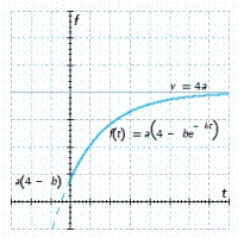
B)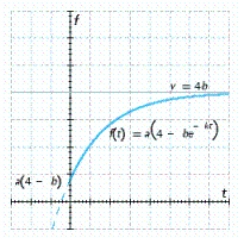
C)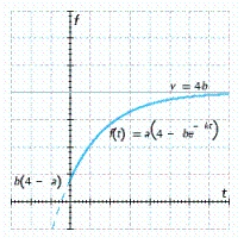
D)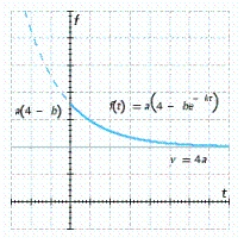
E)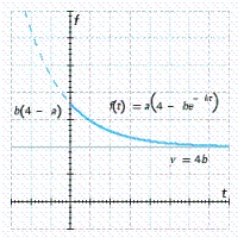
 where a, b, and k are positive constants. Select the graph of f.
where a, b, and k are positive constants. Select the graph of f.A)

B)

C)

D)

E)


Unlock Deck
Unlock for access to all 278 flashcards in this deck.
Unlock Deck
k this deck
29
The concentration of a drug in grams/cubic centimeter (g/cm3) t minutes after it has been injected into the bloodstream is given by  where u, l, and k are positive constants, with l > u. At what time is the concentration of the drug the greatest? What will be the concentration of the drug in the long run?
where u, l, and k are positive constants, with l > u. At what time is the concentration of the drug the greatest? What will be the concentration of the drug in the long run?
A)
B)
C)
D)
 where u, l, and k are positive constants, with l > u. At what time is the concentration of the drug the greatest? What will be the concentration of the drug in the long run?
where u, l, and k are positive constants, with l > u. At what time is the concentration of the drug the greatest? What will be the concentration of the drug in the long run?A)

B)

C)

D)


Unlock Deck
Unlock for access to all 278 flashcards in this deck.
Unlock Deck
k this deck
30
Find the derivative of the function. 
A)
B)
C)
D)

A)

B)

C)

D)


Unlock Deck
Unlock for access to all 278 flashcards in this deck.
Unlock Deck
k this deck
31
On the basis of data collected during an experiment, a biologist found that the growth of the fruit fly (Drosophila) with a limited food supply could be approximated by the exponential model  , where t denotes the number of days since the beginning of the experiment.
, where t denotes the number of days since the beginning of the experiment.
What was the initial fruit fly population in the experiment? __________
What was the maximum fruit fly population that could be expected under this laboratory condition? __________
What was the population of the fruit fly colony on the 20th day? Please give the answer as an integer.__________
How fast was the population changing on the 20th day? Please give the answer as an integer.__________
 , where t denotes the number of days since the beginning of the experiment.
, where t denotes the number of days since the beginning of the experiment.What was the initial fruit fly population in the experiment? __________
What was the maximum fruit fly population that could be expected under this laboratory condition? __________
What was the population of the fruit fly colony on the 20th day? Please give the answer as an integer.__________
How fast was the population changing on the 20th day? Please give the answer as an integer.__________

Unlock Deck
Unlock for access to all 278 flashcards in this deck.
Unlock Deck
k this deck
32
Three hundred students attended the dedication ceremony of a new building on a college campus.The president of the traditionally female college announced a new expansion program, which included plans to make the college coeducational.The number of students who learned of the new program t hours later is given by the function  . If 600 students on campus had heard about the new program 2 hours after the ceremony, how many students had heard about the policy after 4 hours?
. If 600 students on campus had heard about the new program 2 hours after the ceremony, how many students had heard about the policy after 4 hours?
A)975
B)970
C)980
D)960
E)965
 . If 600 students on campus had heard about the new program 2 hours after the ceremony, how many students had heard about the policy after 4 hours?
. If 600 students on campus had heard about the new program 2 hours after the ceremony, how many students had heard about the policy after 4 hours?A)975
B)970
C)980
D)960
E)965

Unlock Deck
Unlock for access to all 278 flashcards in this deck.
Unlock Deck
k this deck
33
The radioactive element polonium decays according to the law  , where
, where  is the initial amount and the time t is measured in days.If the amount of polonium left after 420 days is 80 mg, what was the initial amount present?
is the initial amount and the time t is measured in days.If the amount of polonium left after 420 days is 80 mg, what was the initial amount present?
__________ mg
 , where
, where  is the initial amount and the time t is measured in days.If the amount of polonium left after 420 days is 80 mg, what was the initial amount present?
is the initial amount and the time t is measured in days.If the amount of polonium left after 420 days is 80 mg, what was the initial amount present?__________ mg

Unlock Deck
Unlock for access to all 278 flashcards in this deck.
Unlock Deck
k this deck
34
The percent of a certain brand of computer chips that will fail after t years of use is estimated to be  .
.
What percent of this brand of computer chips are expected to be usable after 5 years? Round your answer to one decimal place.
__________%
 .
.What percent of this brand of computer chips are expected to be usable after 5 years? Round your answer to one decimal place.
__________%

Unlock Deck
Unlock for access to all 278 flashcards in this deck.
Unlock Deck
k this deck
35
Skeletal remains of the so-called "Pittsburgh Man", unearthed in Pennsylvania, had lost 86% of the carbon 14 they originally contained.Determine the approximate age of the bones.Round your answer to the nearest year.Hint: the decay constant k for carbon 14 is equal to 0.00012.
__________ years
__________ years

Unlock Deck
Unlock for access to all 278 flashcards in this deck.
Unlock Deck
k this deck
36
During a flu epidemic, the number of children in the Woodbridge Community School System who contracted influenza after t days was given by  .
.
How many children were stricken by the flu after the first day? Round your answer to the nearest integer.
__________ children
How many children had the flu after 10 days? Round your answer to the nearest integer.
__________ children
How many children eventually contracted the disease? Round your answer to the nearest integer.
__________ children
 .
.How many children were stricken by the flu after the first day? Round your answer to the nearest integer.
__________ children
How many children had the flu after 10 days? Round your answer to the nearest integer.
__________ children
How many children eventually contracted the disease? Round your answer to the nearest integer.
__________ children

Unlock Deck
Unlock for access to all 278 flashcards in this deck.
Unlock Deck
k this deck
37
The U.S.population is approximated by the function  , where P(t) is measured in millions of people and t is measured in 30-year intervals, with t = 0 corresponding to 1930.What is the expected population of the United States in 2050 (t = 4)? Round your answer to one decimal place.
, where P(t) is measured in millions of people and t is measured in 30-year intervals, with t = 0 corresponding to 1930.What is the expected population of the United States in 2050 (t = 4)? Round your answer to one decimal place.
__________ million
 , where P(t) is measured in millions of people and t is measured in 30-year intervals, with t = 0 corresponding to 1930.What is the expected population of the United States in 2050 (t = 4)? Round your answer to one decimal place.
, where P(t) is measured in millions of people and t is measured in 30-year intervals, with t = 0 corresponding to 1930.What is the expected population of the United States in 2050 (t = 4)? Round your answer to one decimal place.__________ million

Unlock Deck
Unlock for access to all 278 flashcards in this deck.
Unlock Deck
k this deck
38
The change from religious to lay teachers at Roman Catholic schools has been partly attributed to the decline in the number of women and men entering religious orders.The percent of teachers who are lay teachers is given by  where t measured in decades, with
where t measured in decades, with  corresponding to the beginning of 1960.
corresponding to the beginning of 1960.
What percent of teachers were lay teachers at the beginning of 1990? Please round the answer to one decimal place.
__________ %
How fast was the percent of lay teachers changing at the beginning of 1990? Please round the answer to two decimal places.
__________ % / year
Find the year when the percent of lay teachers was increasing most rapidly.
 where t measured in decades, with
where t measured in decades, with  corresponding to the beginning of 1960.
corresponding to the beginning of 1960.What percent of teachers were lay teachers at the beginning of 1990? Please round the answer to one decimal place.
__________ %
How fast was the percent of lay teachers changing at the beginning of 1990? Please round the answer to two decimal places.
__________ % / year
Find the year when the percent of lay teachers was increasing most rapidly.

Unlock Deck
Unlock for access to all 278 flashcards in this deck.
Unlock Deck
k this deck
39
Wood deposits recovered from an archeological site contain 22% of the carbon 14 they originally contained.How long ago did the tree from which the wood was obtained die? Round your answer to the nearest year.Hint: the decay constant k for carbon 14 is equal to 0.00012.
__________ years
__________ years

Unlock Deck
Unlock for access to all 278 flashcards in this deck.
Unlock Deck
k this deck
40
A certain piece of machinery was purchased 4 years ago by Garland Mills for $300,000.Its present resale value is $192,000.Assuming that the machine's resale value decreases exponentially, what will it be 3 years from now? Round your answer to the nearest dollar.
$__________
$__________

Unlock Deck
Unlock for access to all 278 flashcards in this deck.
Unlock Deck
k this deck
41
Find the derivative of the function. 
A)
B)
C)
D)

A)

B)

C)

D)


Unlock Deck
Unlock for access to all 278 flashcards in this deck.
Unlock Deck
k this deck
42
Find the derivative of the function. 
A)
B)
C)
D)

A)

B)

C)

D)


Unlock Deck
Unlock for access to all 278 flashcards in this deck.
Unlock Deck
k this deck
43
Find the derivative of the function. 
A)
B)
C)
D)

A)

B)

C)

D)


Unlock Deck
Unlock for access to all 278 flashcards in this deck.
Unlock Deck
k this deck
44
Find the second derivative of the function. 
A)
B)
C)
D)

A)

B)

C)

D)


Unlock Deck
Unlock for access to all 278 flashcards in this deck.
Unlock Deck
k this deck
45
Find the derivative of the function. 
A)
B)
C)
D)

A)

B)

C)

D)


Unlock Deck
Unlock for access to all 278 flashcards in this deck.
Unlock Deck
k this deck
46
Find the derivative of the function. 
A)
B)
C)
D)
E)

A)

B)

C)

D)

E)


Unlock Deck
Unlock for access to all 278 flashcards in this deck.
Unlock Deck
k this deck
47
Find an equation of the tangent line to the graph of  at the point
at the point  .
.
A)
B)
C)
D)
 at the point
at the point  .
.A)

B)

C)

D)


Unlock Deck
Unlock for access to all 278 flashcards in this deck.
Unlock Deck
k this deck
48
Find the derivative of the function. 
A)
B)
C)
D)

A)

B)

C)

D)


Unlock Deck
Unlock for access to all 278 flashcards in this deck.
Unlock Deck
k this deck
49
Use logarithmic differentiation to find the derivative of the function. 
A)
B)
C)
D)

A)

B)

C)

D)


Unlock Deck
Unlock for access to all 278 flashcards in this deck.
Unlock Deck
k this deck
50
Find the second derivative of the function. 
A)
B)
C)
D)
E)

A)

B)

C)

D)

E)


Unlock Deck
Unlock for access to all 278 flashcards in this deck.
Unlock Deck
k this deck
51
Find the derivative of the function. 
A)
B)
C)
D)

A)

B)

C)

D)


Unlock Deck
Unlock for access to all 278 flashcards in this deck.
Unlock Deck
k this deck
52
Find the derivative of the function. 
A)
B)
C)
D)

A)

B)

C)

D)


Unlock Deck
Unlock for access to all 278 flashcards in this deck.
Unlock Deck
k this deck
53
Use logarithmic differentiation to find the derivative of the function. 
A)
B)
C)
D)

A)

B)

C)

D)


Unlock Deck
Unlock for access to all 278 flashcards in this deck.
Unlock Deck
k this deck
54
Find the derivative of the function. 
A)
B)
C)
D)
E)

A)

B)

C)

D)

E)


Unlock Deck
Unlock for access to all 278 flashcards in this deck.
Unlock Deck
k this deck
55
Find the derivative of the function. 
A)
B)
C)
D)

A)

B)

C)

D)


Unlock Deck
Unlock for access to all 278 flashcards in this deck.
Unlock Deck
k this deck
56
Use logarithmic differentiation to find the derivative of the function. 
A)
B)
C)
D)
E)

A)

B)

C)

D)

E)


Unlock Deck
Unlock for access to all 278 flashcards in this deck.
Unlock Deck
k this deck
57
Use logarithmic differentiation to find the derivative of the function. 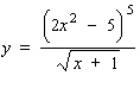
A)
B)
C)
D)
E)

A)

B)

C)

D)

E)


Unlock Deck
Unlock for access to all 278 flashcards in this deck.
Unlock Deck
k this deck
58
Find the derivative of the function. 
A)
B)
C)
D)
E)

A)

B)

C)

D)

E)


Unlock Deck
Unlock for access to all 278 flashcards in this deck.
Unlock Deck
k this deck
59
Find the derivative of the function. 
A)
B)
C)
D)

A)

B)

C)

D)


Unlock Deck
Unlock for access to all 278 flashcards in this deck.
Unlock Deck
k this deck
60
Find the second derivative of the function. 
A)
B)
C)
D)

A)

B)

C)

D)


Unlock Deck
Unlock for access to all 278 flashcards in this deck.
Unlock Deck
k this deck
61
Find the derivative of the function. 


Unlock Deck
Unlock for access to all 278 flashcards in this deck.
Unlock Deck
k this deck
62
Find the derivative of the function. 


Unlock Deck
Unlock for access to all 278 flashcards in this deck.
Unlock Deck
k this deck
63
Find the derivative of the function. 


Unlock Deck
Unlock for access to all 278 flashcards in this deck.
Unlock Deck
k this deck
64
The strain (percent of compression) on the lumbar vertebral disks in an adult human as a function of the load x (in kilograms) is given by  . What is the rate of change of the strain with respect to the load when the load is 300 kg? When the load is 450 kg? Give the answers to four decimal places.
. What is the rate of change of the strain with respect to the load when the load is 300 kg? When the load is 450 kg? Give the answers to four decimal places.
A)
B)
C)
D)
 . What is the rate of change of the strain with respect to the load when the load is 300 kg? When the load is 450 kg? Give the answers to four decimal places.
. What is the rate of change of the strain with respect to the load when the load is 300 kg? When the load is 450 kg? Give the answers to four decimal places.A)

B)

C)

D)


Unlock Deck
Unlock for access to all 278 flashcards in this deck.
Unlock Deck
k this deck
65
Find the derivative of the function. 


Unlock Deck
Unlock for access to all 278 flashcards in this deck.
Unlock Deck
k this deck
66
Find the derivative of the function. 


Unlock Deck
Unlock for access to all 278 flashcards in this deck.
Unlock Deck
k this deck
67
Find the derivative of the function. 


Unlock Deck
Unlock for access to all 278 flashcards in this deck.
Unlock Deck
k this deck
68
Find the inflection points of the function  .
.
A)
B)
C)
D)There are no inflection points.
 .
.A)

B)

C)

D)There are no inflection points.

Unlock Deck
Unlock for access to all 278 flashcards in this deck.
Unlock Deck
k this deck
69
Find the derivative of the function. 


Unlock Deck
Unlock for access to all 278 flashcards in this deck.
Unlock Deck
k this deck
70
On the Richter scale, the magnitude R of an earthquake is given by the formula  where I is the intensity of the earthquake being measured and
where I is the intensity of the earthquake being measured and  is the standard reference intensity.Suppose an earthquake is measured with a magnitude of 6 on the Richter scale with an error of at most 2%.Use differentials to find the error in the intensity of the earthquake.Round your answer to the nearest integer.
is the standard reference intensity.Suppose an earthquake is measured with a magnitude of 6 on the Richter scale with an error of at most 2%.Use differentials to find the error in the intensity of the earthquake.Round your answer to the nearest integer.
A)
B)
C)
D)
E)
 where I is the intensity of the earthquake being measured and
where I is the intensity of the earthquake being measured and  is the standard reference intensity.Suppose an earthquake is measured with a magnitude of 6 on the Richter scale with an error of at most 2%.Use differentials to find the error in the intensity of the earthquake.Round your answer to the nearest integer.
is the standard reference intensity.Suppose an earthquake is measured with a magnitude of 6 on the Richter scale with an error of at most 2%.Use differentials to find the error in the intensity of the earthquake.Round your answer to the nearest integer.A)

B)

C)

D)

E)


Unlock Deck
Unlock for access to all 278 flashcards in this deck.
Unlock Deck
k this deck
71
For children between the ages of 5 and 13 years old, the Ehrenberg equation  gives the relationship between the weight W (in kilograms) and the height h (in meters) of a child.Use differentials to estimate the change in the weight of a child who grows from 1.1 m to 1.4 m.
gives the relationship between the weight W (in kilograms) and the height h (in meters) of a child.Use differentials to estimate the change in the weight of a child who grows from 1.1 m to 1.4 m.
A) kg
kg
B) kg
kg
C) kg
kg
D) kg
kg
E) kg
kg
 gives the relationship between the weight W (in kilograms) and the height h (in meters) of a child.Use differentials to estimate the change in the weight of a child who grows from 1.1 m to 1.4 m.
gives the relationship between the weight W (in kilograms) and the height h (in meters) of a child.Use differentials to estimate the change in the weight of a child who grows from 1.1 m to 1.4 m.A)
 kg
kgB)
 kg
kgC)
 kg
kgD)
 kg
kgE)
 kg
kg
Unlock Deck
Unlock for access to all 278 flashcards in this deck.
Unlock Deck
k this deck
72
Find the derivative of the function. 


Unlock Deck
Unlock for access to all 278 flashcards in this deck.
Unlock Deck
k this deck
73
Find the derivative of the function. 


Unlock Deck
Unlock for access to all 278 flashcards in this deck.
Unlock Deck
k this deck
74
Find the derivative of the function. 


Unlock Deck
Unlock for access to all 278 flashcards in this deck.
Unlock Deck
k this deck
75
Find an equation of the tangent line to the graph of  at its inflection point.
at its inflection point.
A)
B)
C)
D)
E)
 at its inflection point.
at its inflection point.A)

B)

C)

D)

E)


Unlock Deck
Unlock for access to all 278 flashcards in this deck.
Unlock Deck
k this deck
76
For children between the ages of 5 and 13 years old, the Ehrenberg equation  gives the relationship between the weight W (in kilograms) and the height h (in meters) of a child.Use differentials to estimate the change in the weight of a child who grows from 0.8 m to 1 m.Round the answer to the nearest tenth.
gives the relationship between the weight W (in kilograms) and the height h (in meters) of a child.Use differentials to estimate the change in the weight of a child who grows from 0.8 m to 1 m.Round the answer to the nearest tenth.
__________ kg
 gives the relationship between the weight W (in kilograms) and the height h (in meters) of a child.Use differentials to estimate the change in the weight of a child who grows from 0.8 m to 1 m.Round the answer to the nearest tenth.
gives the relationship between the weight W (in kilograms) and the height h (in meters) of a child.Use differentials to estimate the change in the weight of a child who grows from 0.8 m to 1 m.Round the answer to the nearest tenth.__________ kg

Unlock Deck
Unlock for access to all 278 flashcards in this deck.
Unlock Deck
k this deck
77
Find the derivative of the function. 


Unlock Deck
Unlock for access to all 278 flashcards in this deck.
Unlock Deck
k this deck
78
Use the curve-sketching guideline, to select the graph of the function. 
A)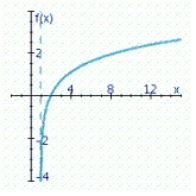
B)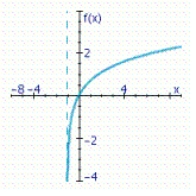
C)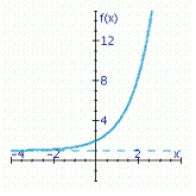

A)

B)

C)


Unlock Deck
Unlock for access to all 278 flashcards in this deck.
Unlock Deck
k this deck
79
Find the derivative of the function. 


Unlock Deck
Unlock for access to all 278 flashcards in this deck.
Unlock Deck
k this deck
80
Find the inflection points of the function  .
.
A)
B)
C)
D)
E)
 .
.A)

B)

C)

D)

E)


Unlock Deck
Unlock for access to all 278 flashcards in this deck.
Unlock Deck
k this deck



